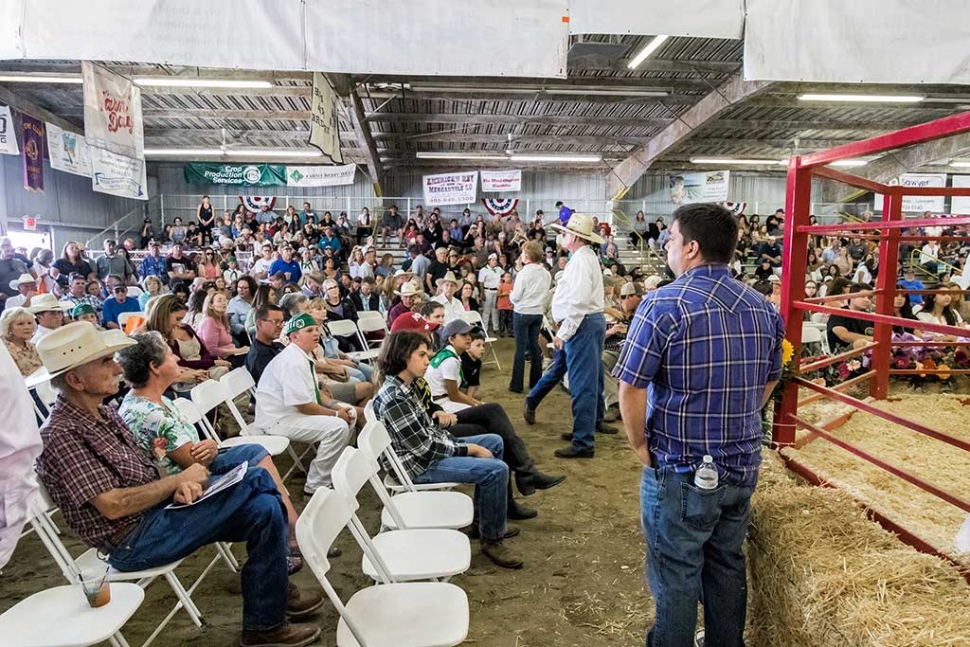|
Photography Know-How
 Photo of the Week: "Bidders and spectators at the Junior Livestock Auction at the Ventura County Fair" by Bob Crum. Photo data: ISO 6400, 16-300mm lens @16mm, f/7.1, 1/125 second. By Bob Crum — Wednesday, August 16th, 2017
Survived another Fair
 Bob Crum I thoroughly enjoy the fantabulous Ventura County Fair. But thank goodness it's over! Recreationally speaking, the multitude of photo ops is bliss. On the other hand, shooting the kids with animals in the Junior Livestock Auction ring is a daunting task... my most challenging assignment of the year. Nevertheless, I miraculously survived... though still recovering. Why such a challenge? First, the lighting in the venue is horrible... a combination of outside ambient light and overhead fluorescent lights. Furthermore, the size of the auction ring makes it difficult to get a respectable composition. And y'all know how heartily I emphasize composition. Because the venue lacks sufficient light, shutter speed and aperture are a balancing act. If I open the aperture too wide I loose depth-of-field. If I slow down the shutter speed too much to compensate for the lack of sufficient light, I risk blur. Focus is another issue. If I back up I risk the auction ring railing grabbing the focus and putting the subject in the ring out of focus. If I get to the railing, I'm too close to get a kid and a 1,238 pound steer in the frame. No time to change the focus mode on the fly. Given the circumstances, I compromise the shutter speed and aperture while letting the ISO float on 'auto'. But as the ISO floats to compensate for the lousy lighting, it goes pretty high. As it goes over 1200 on my Canon 7DMKII, noise becomes stronger. If you remember, digital noise looks like micro-sized flecks in the image. Treating the noise requires extra steps in during post processing. Worse, as I increase the noise reduction strength, detail is sacrificed. Balancing between noise treatment and detail preservation is a challenge. Hopefully, none of my trials and tribulations cause any of you to take pause. While it appears to be tedious work, from the shoot to post processing, it all becomes second nature with practice. Is this any different than you deciding to play a musical instrument? Is it possible to become a virtuoso without practice??? Photography also takes practice! Now the important yet rewarding part: Creativity. Photography is much more than taking snapshots. It's about creating in image. Creativity is the ability to frame a composition that results in a compelling image. A frequent comment I hear repeatedly is that they have a digital camera but don't get the same photos that I do. Well, good composition is just as much a result of lots of practice as well as technical know-how. Technical know-how permits you to capture good compositions with correct exposure. And focus! The combination of technical know-how and the art of framing good compositions is what makes photography fascinating... and rewarding. One other thing: Post processing. The camera is merely a computer that a lens is attached to. It's the first half of taking a photo. No image straight out of the camera is as good as it could be. Processing the image... from RAW data to a Tiff or Jpeg is the other important half. More on post processing in a future column. If you don't have any plans for this weekend, consider spending a day at the Camarillo airport for the Wings Over Camarillo air show Saturday the 19th and Sunday the 20th. The ground display which includes many war planes of yesteryear is awesome. The air show is a treat. Go the website http://wingsovercamarillo.com/and you'll see my photo/video of photos I shot last year. See you there! Cameras UP! Happy photoing, Send comments, questions or suggestions to bob@fillmoregazette.com |
